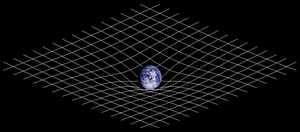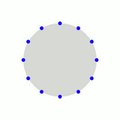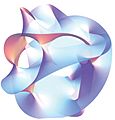General relativity facts for kids

The General Theory of Relativity, often called just general relativity, was published by Albert Einstein in 1915, ten years after the special theory of relativity was created. Einstein's general theory of relativity uses the idea of spacetime. Spacetime is the fact that we have a four-dimensional universe, having three spatial (space) dimensions and one temporal (time) dimension. Any physical event happens at some place inside these three space dimensions, and at some moment in time. According to the general theory of relativity, any mass causes spacetime to curve, and any other mass follows these curves. Bigger mass causes more curving. This was a new way to explain gravitation (gravity).
General relativity explains gravitational lensing, which is light bending when it comes near a massive object. This explanation was proven correct during a solar eclipse, when the sun's bending of starlight from distant stars could be measured because of the darkness of the eclipse.
General relativity also set the stage for cosmology (theories of the structure of our universe at large distances and over long times). Einstein thought that the universe may curve a little bit in both space and time, so that the universe always had existed and always will exist, and so that if an object moved through the universe without bumping into anything, it would return to its starting place, from the other direction, after a very long time. He even changed his equations to include a "cosmological constant," in order to allow a mathematical model of an unchanging universe. The general theory of relativity also allows the universe to spread out (grow larger and less dense) forever, and most scientists think that astronomy has proved that this is what happens. When Einstein realized that good models of the universe were possible even without the cosmological constant, he called his use of the cosmological constant his "biggest blunder," and that constant is often left out of the theory. However, many scientists now believe that the cosmological constant is needed to fit in all that we now know about the universe.
A popular theory of cosmology is called the Big Bang. According to the Big Bang theory, the universe was formed 15 billion years ago, in what is called a "gravitational singularity". This singularity was small, dense, and very hot. According to this theory, all of the matter that we know today came out of this point.
Einstein himself did not have the idea of a "black hole", but later scientists used this name for an object in the universe that bends spacetime so much that not even light can escape it. They think that these ultra-dense objects are formed when giant stars, at least three times the size of our sun, die. This event can follow what is called a supernova. The formation of black holes may be a major source of gravitational waves, so the search for proof of gravitational waves has become an important scientific pursuit.
Contents
Examples
Einstein said time and mass change during motion.
Imagine you are flying through space in a space race with a friend. You both wear identical watches. If you travel much faster, closer to the speed of light and pass your friend, your watch will be ticking more slowly than their watch. Your friend will see their watch ticking faster than yours (physicists call this effect "time dilation"). Your friend will also see you becoming smaller and you will see your friend becoming bigger.
These size and time changes are present at any speeds but are only noticeable at very high speeds that are close to the speed of light (186,000 miles (299,000 km) per second), so we don't notice them in our every day life.
Einstein also said that objects actually bend space around them. How do they do this? If you throw a ball next to an elephant, its path will curve towards the elephant as it passes the elephant. This is because the elephant's mass generates "gravity" around it, bending space. Also, the more mass something has, the more the effect. So the elephant will have things curve towards him more than things will curve towards you, because you have less mass.
All objects bend space around them (even children in class), but it only becomes visually noticeable for very big objects like planets and stars.
Related pages
Images for kids
-
Orbital decay for PSR J0737−3039: time shift (in s), tracked over 16 years (2021).
-
Projection of a Calabi–Yau manifold, one of the ways of compactifying the extra dimensions posited by string theory
See also
 In Spanish: Relatividad general para niños
In Spanish: Relatividad general para niños







